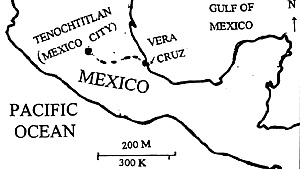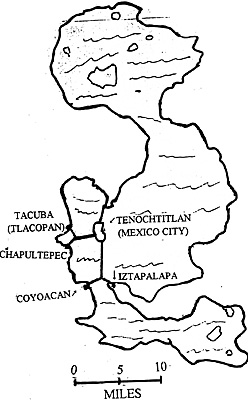 Cortes landed in Mexico in 1519 and named the place he landed Vera Cruz. Once his troops were ashore he burned his ships. His force began a march into the unknown. Indian reactions varied. Sometimes they simply attacked the Spanish. In one case they welcomed the Spanish to their homes but plotted to kill them while they slept. Montezuma, leader of the Aztecs, gathered information and waited. Eventually he met the Spaniards and welcomed them as guests.
Cortes landed in Mexico in 1519 and named the place he landed Vera Cruz. Once his troops were ashore he burned his ships. His force began a march into the unknown. Indian reactions varied. Sometimes they simply attacked the Spanish. In one case they welcomed the Spanish to their homes but plotted to kill them while they slept. Montezuma, leader of the Aztecs, gathered information and waited. Eventually he met the Spaniards and welcomed them as guests.
He brought them to the Aztec capital, Tenochtitlan, located where Mexico City is today. He gave them presents including some gold. While still in Tenochtitlan the Spaniards seized Montezuma and demanded more gold. The Aztecs were outraged and rose up against the Spaniards. Depending on who you believe, Montezuma was killed by the Aztecs as he spoke urging them to let the Spanish go, or he was killed by the Spanish.
Either way, once he was dead, the Spaniards fought their way out of the city. It was not easy. Many were killed including some who fell into the lake and drowned because they would not give up the gold they were carrying. Once outside the city, the Spanish received some reinforcements from Cuba and began a campaign to take over the Aztec Empire by besieging Tenochtitlan.
Siege of Tenochtitlan
 But the city was a tough nut. The Aztecs had built it in the middle of a lake. It could be reached by going along causeways built through the lake. The lake also served as a transport link. Canoes hauled food for the city. Lake water was not potable so water was brought in through an aqueduct. This was the most obvious weakness of the city.
But the city was a tough nut. The Aztecs had built it in the middle of a lake. It could be reached by going along causeways built through the lake. The lake also served as a transport link. Canoes hauled food for the city. Lake water was not potable so water was brought in through an aqueduct. This was the most obvious weakness of the city.
The Aztec Empire had one other serious weakness. The subject peoples hated the Aztecs. Soon the Spanish had thousands of Indian allies eager to fight the Aztecs, at least as long as the Spanish were winning. When Cortes organized his forces for an attack on Tenochtitlan, he had at least 24,000 and perhaps as many as 75,000 allied warriors. Spanish reports do not agree on the numbers. I’ll use Cortes’ numbers with another Spanish source’s numbers after them in parenthesis.
Cortes formed three divisions, each under a Spanish leader. Pedro de Avarado led a force of 150 soldiers with pikes or swords, 30 horsemen, 18 musketeers or crossbow men, and 25,000 (8000) Indian warriors. This force was based at Tacuba. Cristebal de Olid had 170 (175) soldiers, 33 (30) horsemen, and 18 (20) musketeers and crossbow men plus over 20,000 (8000) Indians. They were based at Coyoacan. Gonzalo de Sandevol led 150 soldiers, 24 horsemen, 13 (14) musketeers and crossbow men and 30,000 (more than 8000) Indians. They were to attack Iztapalapa.
In addition there were the boats. Cortes personally commanded them. The need for boats became clear as the siege developed. The history of the siege of Tenochtitlan contains a number of situations involving boats. This is more a selected list than a comprehensive narrative, but the events are arranged in chronological order.
The Spanish started their siege by cutting off the water supply to the city. Next they attempted to fight their way down a causeway from Tacuba into the city. The causeway was about a mile long and 8 yards wide with water on both sides. At some places it was broken by bridges. The Aztecs tore up these bridges and the resulting gaps became defended strong points. Two divisions of the Spanish forces moved down the causeway to the bridges. They were met by Aztec defenders. As the land forces battled, the Aztecs sent thousands of canoes onto the lake and attacked the Spanish flanks. The men in the canoes were protected by wooden bulwarks, and threw spears, arrows, and stones. The Spanish retreated.
After this, Cortes had 13 boats built. Different translators call them launches, brigs, or brigantines. The Spanish cut and shaped parts of the boats near the seacoast, then transported them overland to be assembled on the lake. Cortes then took them out on the water to challenge the Aztecs. He kept his fleet huddled together as they rowed out on the lake. Aztec canoes came out in large numbers to attack them. When a “land breeze” developed, he had his launches dash toward the canoes using both sails and oars. They turned over many canoes and chased others into narrow channels between houses. The Spaniards could not follow them because people on the house tops were throwing stones etc. After this battle of the lake, the Spanish boats dominated the lake, but there were limits.
The Spanish boats were larger than canoes and drew more water. The lake had shallow spots and sometimes Spanish boats ran aground. There were islands of reeds in the lake as well. The Spanish had to sound the lake to find good channels. The Aztecs made all this more difficult by planting fields of sharp stakes in the lake to spear the Spanish hulls. This would often stop them, but the brigs could break free by rowing vigorously. As fighting approached the city, the Aztecs would attack the brigs from the roofs of houses. A Spanish boat sailing up a canal would be pelted with stones, spears, etc. Generally the Spanish did not sail into such canals.
One of the missions of the Spanish boats was to close the lake to canoes bringing food into the city. Once the Aztecs lured this patrol into a trap. One night the Aztecs hid 30 canoes camouflaged with reeds and branches among the reed islands. Then they sent out two canoes carrying food and water. Two Spanish launches spotted the canoes and gave pursuit. The canoes fled before them leading the launches toward the ambush. The launches followed and ran on to sharp stakes set in the water. Then the brigs and their crews were captured by the Aztecs in the canoes that had been waiting in hiding.
Later, Cortes was able to defeat this tactic. The Aztecs had set up another ambush using forty canoes and sharp stakes, but two prisoners told Cortes about the trap. At night Cortes hid six launches camouflaged with reeds about 3/4 of a mile from the ambush site. When the Aztecs sent out canoes as bait, a single Spanish boat chased them, but it turned away before hitting the stakes. The forty Aztec canoes came out of hiding and pursued the launch. The canoes followed the launch until there was a gun shot. At this signal the six concealed launches attacked and turned over several canoes killing some warriors and taking others prisoner.
The Spanish also used their launches to fight their way down the causeway into the city. They put launches on each side. While the support of the launches made it possible for the Spanish land forces to fight their way up the causeway, it was not easy for the launches. They had to beware of shallow water or stakes positioned to impale them. Aztec canoes tried to tip them over and if they got close to houses they would be pelted with spears, arrows, and stones from the roof tops. But the brigs were not always alone. In some fights there were as many as two hundred canoes full of Indian allies fighting beside the Spanish boats. The combination of land and water forces made it possible for the Spanish to attack up the causeway into Tenochtitlan.
Bibliography
Diaz, Bernal. The Conquest of New Spain (1963).
Cortes, Hernando. Five Letters from Mexico (1998).
Fernandez-Armesto, Felipe. “Naval Warfare after the Viking Age,” pp. 230-252 in Keen, Maurice (ed.) Medieval Warfare: A History (1999).
Keen, Benjamin. Americans All: The Story of Our Latin American Neighbors (1966).
Leon-Portilla, Miguel. The Broken Spears: The Aztec Account of the Conquest of Mexico (1962).
Lombardi, Cathryn, John V. Lombardi and K. Lynn Stiner. Latin American History: A Teaching Atlas (1983).
Von Hagen, Victor W. The Aztec: Man and Tribe (1958).
More Conquest of Mexico 1521
Back to Table of Contents -- Lone Warrior #133
Back to Lone Warrior List of Issues
Back to MagWeb Magazine List
© Copyright 2001 by Solo Wargamers Association.
This article appears in MagWeb (Magazine Web) on the Internet World Wide Web.
Other military history articles and gaming articles are available at http://www.magweb.com
